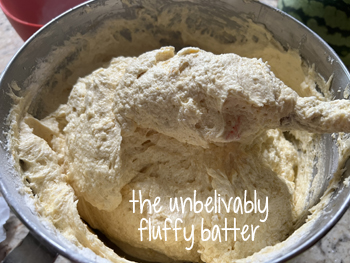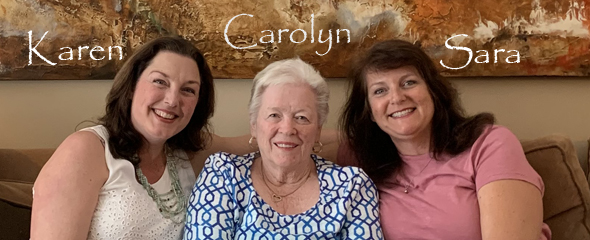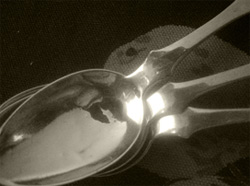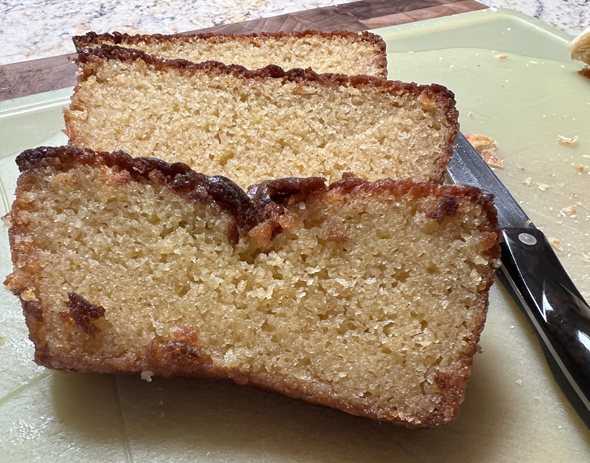If you were to be able to leap into that photo and grab just a bite of this cake you’d have something ethereal. So very tender. So very lemony, and almond-y at the same time. Almost melts in your mouth.
At post from Carolyn. I needed something for two group things I was attending. Needed a dessert to take to one of my book groups, then needed another one for a morning book group too that met at my home at 9:30 am the following day. Totally different people, so it was okay that I served this cake both times. So I doubled the recipe and made this. The recipe comes from Flo Braker. I don’t own her cookbook, but must have found this one online somewhere. I stuck to the recipe except for one tiny thing – I used almond extract instead of vanilla; otherwise, this is Flo’s recipe.
When you make this, just know from the get-go that you won’t have a cake in hand (so to speak) for several hours, as it needs cooling time and resting or firming-up time. It’s an extremely tender cake. So tender that it’s quite a feat to get it off of the cooling racks (use double spatulas). But it’s so very worth it. You can make this a day or two ahead, even. I’m going to add that note in my recipe below – it keeps beautifully.
The making of this batter is DIFFERENT. Once you read the instructions, you’ll understand why. First, and foremost, you need a tube of almond paste. I don’t know about you, but I’ve purchased it on occasion, and then forgot about it on my pantry shelf, and it turned hard as a rock. It’s unusable in that condition. So make sure you have fresh almond paste, that’s still soft to the touch.
The first instructions that are different is how you manipulate the almond paste. My experience didn’t quite match Flo’s instructions, but it all worked out eventually. You mix the almond paste (I broke it up into pieces and added it to the bowl of my stand mixer), and you’re supposed to mix it until it’s turned into little pea-sizes. Well, no, mine didn’t do that, it congealed into one big piece and climbed it’s way up the blade of the mixer. Twice I tried to make it malleable – it was soft, but it would not break up no matter what I did. So finally I added in a little bit of sugar. That seemed to get it more on the right track. So gradually I added the sugar until it did break up well enough. It’s important you do this right as once you begin adding other ingredients you do not want any little globs (tiny as they might be) of almond paste. So take your time in that portion of making this.
 Next you add in butter (very softened). As you watch it, it incorporates the butter – you add it one tablespoon at a time, and it’s important you do that so it aerates. That part should take 3-4 minutes. I guess the batter could “break” if you don’t do it right. Toward the end I was concerned, but it held. Next were eggs, and those were to be added a tablespoon at a time too. Very time consuming, but you don’t want to make a mistake this far into the process. The last part was adding in the dry ingredients (a very little amount of cake flour, baking powder and salt). I did that by hand. In the photo you can see the batter – I tasted it (yes, I know, raw eggs and all) because I wanted to make sure there weren’t any little bits of almond paste (there weren’t).
Next you add in butter (very softened). As you watch it, it incorporates the butter – you add it one tablespoon at a time, and it’s important you do that so it aerates. That part should take 3-4 minutes. I guess the batter could “break” if you don’t do it right. Toward the end I was concerned, but it held. Next were eggs, and those were to be added a tablespoon at a time too. Very time consuming, but you don’t want to make a mistake this far into the process. The last part was adding in the dry ingredients (a very little amount of cake flour, baking powder and salt). I did that by hand. In the photo you can see the batter – I tasted it (yes, I know, raw eggs and all) because I wanted to make sure there weren’t any little bits of almond paste (there weren’t).
 Into a bread pan it goes, using an offset spatula to level the batter. Bakes for about 30 minutes until golden brown. Remove, cool completely and serve. Now my loaf (two, I made, remember) had a little sink in the middle. I’m not sure why that happened, but it made no difference in the long run as you turn the loaf over (upside down). On the pieces in the center of the cake, I cut those in half so it wasn’t at all noticeable.
Into a bread pan it goes, using an offset spatula to level the batter. Bakes for about 30 minutes until golden brown. Remove, cool completely and serve. Now my loaf (two, I made, remember) had a little sink in the middle. I’m not sure why that happened, but it made no difference in the long run as you turn the loaf over (upside down). On the pieces in the center of the cake, I cut those in half so it wasn’t at all noticeable.
What’s GOOD: the very soft, tender crumb and the over-the-top lemon and almond flavor. A keeper.
What’s NOT: only that you need almond paste on hand (or make your own).
printer-friendly PDF and MasterCook file (click link to open recipe)
* Exported from MasterCook *
Almond Lemon Tea Cake
Recipe By: Adapted slightly from Flo Braker’s “The Art of Simple Baking”
Serving Size: 14 (maybe more)
CAKE:
3/4 cup cake flour
1/2 teaspoon baking powder
1/8 teaspoon salt
5 large eggs — at room temperature, lightly beaten
1 teaspoon almond extract
7 ounces almond paste — (3/4 cup) at room temperature
1 cup granulated sugar
8 ounces unsalted butter — (2 sticks) at room temperature, cut into 16 pieces
1 tablespoon lemon zest — finely grated Meyer lemon
GLAZE:
2/3 cup granulated sugar
5 tablespoons lemon juice — freshly squeezed Meyer
NOTE: Allow ample time for prep of this cake, PLUS 3 hours of cooling time before serving, so at least 4 hours. If you use regular lemons, add more sugar to the cake batter.
1. Position a rack in the lower third of an oven. Preheat to 350°F. Lightly butter and flour a 9×5-inch loaf pan; tap out the excess flour.
2. CAKE: Sift together the flour, baking powder and salt twice. Set aside.
3. In a small bowl, combine the eggs and almond extract. Whisk to just combine. Set aside.
4. In the bowl of a stand mixer using the paddle attachment, beat the almond paste on low speed until pea-size crumbs form, about 30 seconds to 1 minute. [If the paste doesn’t break up, but stays in one piece, begin next step very slowly with adding a bit of sugar. Beat further until the almond paste begins to separate.] Slowly add the granulated sugar in a slow, steady stream and beat until incorporated. This should take about 2 to 3 minutes. If you add the sugar too quickly, the almond paste won’t break up as well. Make certain there are no little pieces of amond paste in the batter at this point. Taste the batter to make sure!
5. On low speed, beat in the very softened butter, tablespoon by tablespoon. This should take about 1 minute. Scrape down the sides of bowl. Increase speed to medium and cream the mixture until lighter in color and fluffy in appearance, about 3 to 4 minutes.
6. Still on medium speed, slowly add in the eggs, cautiously at first, tablespoon by tablespoon. After each bit of the eggs have been absorbed, add more. If at any time the mixture appears watery or shiny, stop the flow of eggs and increase the speed until a smooth appearance returns. Then decrease the speed to medium and resume adding the eggs.
7. Continue to cream, stopping the mixer to scrape down the sides of the bowl at least once, until the mixture appears fluffy, velvety and nearly white, and has increased in volume. Including the time to add the eggs, this should take about 2 to 3 minutes. Fold in the Meyer lemon zest. Remove bowl from stand mixer and using a large spatula fold in the flour mixture. Continue folding until no more flour streaks appear.
8. Spoon the batter into the prepared pan and smooth the surface gently with an offset spatula. Bake until a toothpick inserted into the center of the cake comes out clean and the top springs bake when lightly touched, about 45 to 50 minutes or until it reaches 200° in the center, using a instant read thermometer. It might require another 5 minutes of baking to reach that temperature. Transfer the pan to a wire rack and let the cake cool in the pan for 5-10 minutes. Don’t be alarmed if the cake has a little dip in the middle – you’ll be turning the cake upside down anyway.
9. GLAZE: Make the glaze while the cake is cooling in the pan. In a bowl, stir together the sugar and Meyer lemon juice until smooth.
10. Set the wire rack over a sheet of parchment paper, waxed paper or foil to catch any drips of glaze. Invert the loaf pan onto the rack and very carefully lift off the pan. Do not turn cake back over, but leave it top down. Using a silicone pastry brush, generously brush the entire warm cake (top and sides) with the glaze. Continue glazing until you’ve used all of the glazing mixture. Let the cake cool completely on the rack, at least 3 hours, or until the glaze has set. The cake is fragile when warm so don’t try to move it.
11. When the cake is cool, gently transfer it to a serving platter by inserting 2 large spatulas (one from each end) to fully support the cake. Serve at room temperature. Ideally slice in thicker slices, but you may cut them in half (makes them easier to pick up if you decide this is finger food). This will keep, wrapped in plastic wrap, at room temperature for 3-4 days. Ideally, make this cake the day before you need it, allowing all that glaze to absorb to the center.
Per Serving: 328 Calories; 19g Fat (50.7% calories from fat); 4g Protein; 37g Carbohydrate; 1g Dietary Fiber; 101mg Cholesterol; 63mg Sodium; 29g Total Sugars; trace Vitamin D; 53mg Calcium; 1mg Iron; 88mg Potassium; 99mg Phosphorus.







Leave a Comment!